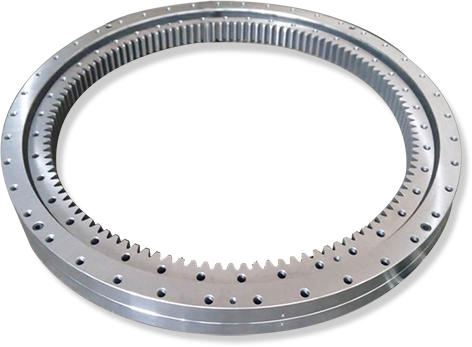The slewing bearing can simultaneously withstand large axial loads, radial loads and overturning moments and other comprehensive loads. It has the characteristics of compact structure, easy to guide rotation, easy installation and easy maintenance. It is widely used in engineering, mining, metallurgy, wind power generation, ships, ports, petroleum, chemical industry, light industry, medical equipment, food, vehicles, robots, etc. , Aerospace, radar, and military industries. Due to installation, working environment and inadequate daily maintenance and other conditions, it is easy to cause defects in the raceway surface. Today, the slewing bearing manufacturer will analyze the reasons for the defects in the raceway surface of the slewing bearing for your reference.
1. Analysis of the causes of spalling on the raceway surface
Due to the serious unevenness or plane distortion of the raceway; after heavy load, the local pressure is too large and exceeds the contact strength of the raceway; due to point impact or long-term overload work, fatigue damage is caused; the raceway is rusted, cracks and gradually expanded; Local strong impact causes the hardened layer to fracture; the hardened layer is uneven or too thin; the harder foreign matter remains in the raceway, which causes the local pressure to be too large; the strip structure in the raw material destroys the hardened layer.

2. Analysis of the cause of pitting or pitting in the raceway and roller
There are hard debris such as sand and iron filings in the raceway; long-term operation of the local raceway under high contact strength causes local fatigue. Due to poor seal maintenance, rainwater or cleaning fluid is immersed in the raceway, causing local pitting or pitting in the raceway and roller; insufficient or loose assembly bolt pre-tightening force causes the axial gap to increase, and the roller is relatively The large overturning moment rotates, the contact stress on the edge of the raceway increases sharply and slips, and the large stress that the roller actually bears is prone to pitting corrosion.
3. Analysis of the reason for the regular linear indentation on the raceway surface
The main reason is that the slewing bearing is statically vibrating at a fixed position for a long time. For example, when a truck crane travels in a rugged and uneven terrain for a long time, the axial clearance increases, causing the roller bus bar to impact the raceway, resulting in linear indentations with equal spacing.
For precision measuring equipment, in order to improve the anti-overturning rigidity of the turntable bearing, it needs to have a certain negative clearance, which will inevitably bring a quantitative static friction torque, and at the same time, an appropriate static friction torque is also required, which is conducive to reducing Oscillation of small systems. But if the static friction torque is too large, it will also bring undesirable consequences.
In order to prevent excessive static friction torque from appearing, the appropriate selection of negative clearance is important, but at the same time, it is necessary to ensure that the radial fit between the turntable bearing and the turntable and the base has a proper clearance, and pay attention to the installation and fastening methods to avoid distortion of the raceway.


